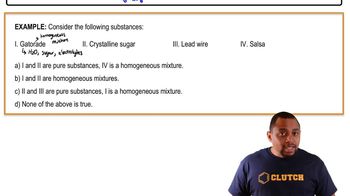Ch.23 - Organic and Biological Chemistry
Chapter 23, Problem 73
Write the open-chain structure of a four-carbon deoxy sugar.
 Verified step by step guidance
Verified step by step guidance1
Step 1: Understand that a deoxy sugar is a sugar molecule where one of the hydroxyl groups (-OH) is replaced by a hydrogen atom (H).
Step 2: Recognize that a four-carbon sugar is known as a tetrose. The simplest form of a tetrose is an aldotetrose, which has an aldehyde group at one end.
Step 3: Draw the basic structure of an aldotetrose, which includes four carbon atoms in a chain with an aldehyde group (CHO) at the first carbon and hydroxyl groups on the other carbons.
Step 4: Replace one of the hydroxyl groups (-OH) on the carbon chain with a hydrogen atom (H) to create the deoxy sugar. This can be done at any carbon except the one with the aldehyde group.
Step 5: Ensure the structure maintains the correct number of hydrogen atoms and bonds, resulting in a four-carbon deoxy sugar with the general formula C4H8O3.
Key Concepts
Here are the essential concepts you must grasp in order to answer the question correctly.
Deoxy Sugars
Deoxy sugars are carbohydrates that have lost one or more hydroxyl (-OH) groups, typically at the 2-position. In the case of a four-carbon deoxy sugar, this means that the sugar will have four carbon atoms and one less oxygen than its corresponding sugar. An example is 2-deoxy-D-ribose, which is a crucial component of RNA.
Recommended video:
Guided course

Classification of Matter Example
Open-Chain Structure
The open-chain structure of a sugar refers to its linear form, as opposed to its cyclic form. In this structure, the carbon atoms are connected in a straight chain, with functional groups such as aldehydes or ketones at one end. For a four-carbon deoxy sugar, the open-chain structure will consist of four carbon atoms linked by single bonds, with the appropriate hydrogen and oxygen atoms attached.
Recommended video:
Guided course

Resonance Structures
Structural Representation
Structural representation in chemistry involves depicting the arrangement of atoms within a molecule. For sugars, this includes showing the carbon backbone and the positions of functional groups. In drawing the open-chain structure of a four-carbon deoxy sugar, it is essential to accurately represent the carbon atoms, the absence of the hydroxyl group, and the placement of hydrogen atoms to reflect the correct molecular formula.
Recommended video:
Guided course

Resonance Structures
Related Practice
